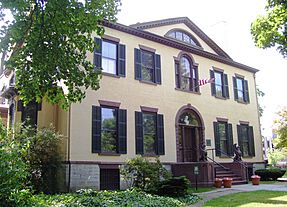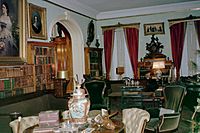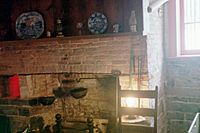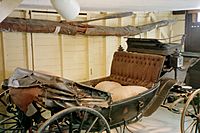William H. Seward House facts for kids
|
Seward House Museum
|
|
 |
|
| Location | 33 South St., Auburn, NY |
|---|---|
| Area | 2.5 acres (1.0 ha) |
| Built | 1816–1817 |
| Website | SewardHouse.Org |
| NRHP reference No. | 66000504 |
Quick facts for kids Significant dates |
|
| Added to NRHP | October 15, 1966 |
The William H. Seward House Museum is a special historic home located at 33 South Street in Auburn, New York. This house, built around 1816, was the home of William H. Seward (1801–1872). He was a very important person in American history.
William Seward served as a state senator in New York and later became the governor of New York. He also served as a U.S. senator. Later, he became the Secretary of State, which is a top advisor to the President, working for presidents Abraham Lincoln and Andrew Johnson.
The Seward House was recognized as a National Historic Landmark in 1964. It was added to the National Register of Historic Places on October 15, 1966. Today, a non-profit group takes care of the house. They run it as a museum to teach people about William Seward's life and work. Interestingly, Seward's house is on the same street as the home of Harriet Tubman, another famous historical figure.
About the Seward House
The Seward House is located south of downtown Auburn. It sits on the west side of South Street, across from Grover Street. The main part of the house is a two-story brick building with a pointed roof.
William Seward made many changes to the house over the years. In 1847, he added a two-story tower and a new section on the west side. He also added a covered entrance for carriages and a carriage house. In 1866, he added another narrower section and a three-story tower to the south side. More separate carriage houses were built further south on the property.
History of the Home
The main part of the house was built in 1816 by Judge Elijah Miller. He was William Seward's father-in-law. Much of the building work was done by a carpenter named John C. Jeffries. His apprentice, Brigham Young, also helped build the house. Brigham Young later became a famous leader of the Church of Jesus Christ of Latter-day Saints.
The house stayed in the Seward family for many years. In 1951, it was given to a non-profit group. This group then turned it into the museum we see today.
William Seward's Legacy
William Seward achieved many important things during his life. One of his most famous actions was negotiating the purchase of Alaska from Russia in 1867. At the time, some people thought this was a bad idea and called it "Seward's Folly." However, it turned out to be a very smart decision for the United States.
Even though he spent many years working in Albany (New York's capital) and Washington, D.C. (the nation's capital), William Seward always considered this house his true home. He lived here from the time he got married in 1824 until he passed away. The entire house is still filled with many original items and collections that belonged to the Seward family.
Images for kids






